Highway 413: The Opposition Reloads
The Ford government has resurrected the controversial highway that will cut through south Caledon. Is it a done deal?
When Jenni Le Forestier, a community-minded music teacher who lives in Belfountain, first heard nearly a decade ago about the Ontario government’s plan to drive a 400-series highway through southern Caledon’s verdant farmlands and forests, she was dumbfounded.
“I was incredulous that anyone – let alone a set of municipal and provincial politicians who claim to care about the environment and climate change – would want to wreck a big swath of the very last undeveloped lands remaining in the Greater Toronto Area,” she recalls.
Determined to understand more, Le Forestier joined a government-sponsored community action group established to allow public input. But she was not reassured by what she learned, and she celebrated when Kathleen Wynne’s Liberal government took the advice of its expert advisory panel and kiboshed the project in early 2018. So in June 2019, when Premier Doug Ford announced his government was reviving the project, Le Forestier found herself girding for battle.
The proposed GTA West Transportation Corridor, known informally as Highway 413, originated as a component of the 2005 Places to Grow Act which set out population density and growth targets for municipalities while aiming to direct growth away from agricultural and environmentally sensitive lands. Places to Grow envisioned a potential transportation corridor connecting the evolving urban growth centres west of the GTA.
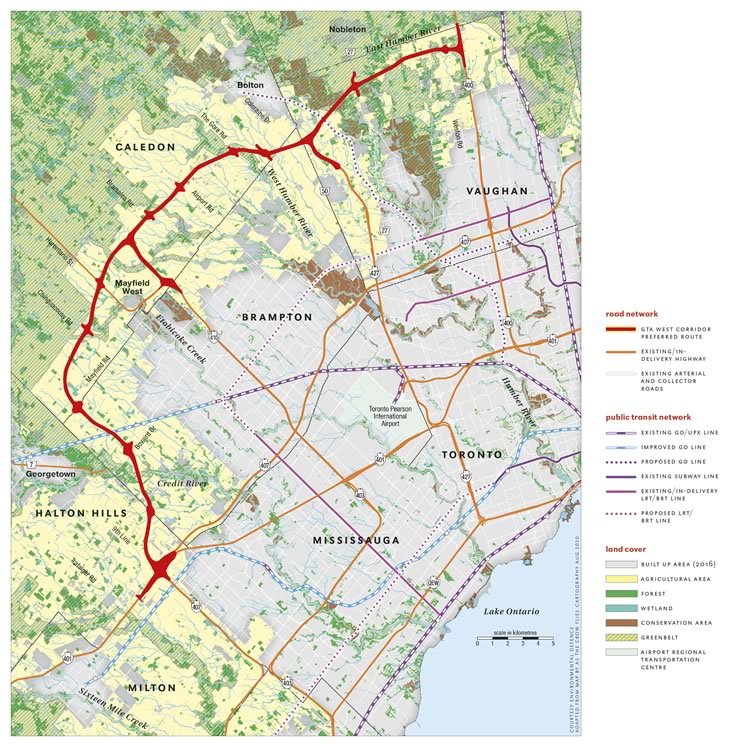
Courtesy Environmental Defence adapted from map by As The Crow Flies Cartography Aug 2020. Updated March 2021. Click on the map for larger version of the file.
The multimodal corridor will include traffic lanes and a transitway, with potential priority for goods movement. It will stretch 50 kilometres from Vaughan in the east, through Brampton and Caledon, into Halton in the west. Spaghetti junctions will connect to four other 400-series highways, two of them, the 410 and 427, in Caledon. About 170 metres wide, the corridor will pave over some 2,000 hectares of land and cross the Humber and Credit watersheds, as well as the upper reaches of Etobicoke Creek.
In August 2020, the Ministry of Transportation laid out the “technically preferred route” for the highway and commenced the second stage of the environmental assessment study begun in 2007. This past July, the government passed its omnibus Bill 197, the Covid-19 Economic Recovery Act, which gutted a plethora of environmental regulations, opening the door for “a streamlined environmental assessment process” for the highway, as well as reducing the ability of landowners to challenge expropriations for public roads and transit projects.
The multibillion dollar highway is expected to host more than 300,000 vehicle trips a day, says Natasha Tremblay, spokesperson for Ontario transport minister Caroline Mulroney. Its purpose is to reduce travel times for commuters and goods, Tremblay says, along with “providing greater connectivity between urban growth centres, providing better connections to residential and employment lands, providing an alternate route in the event of an incident or road closure on local roads, providing a designated transitway as a multimodal alternative, and providing greater economic vitality.”
Although Caledon generates a small fraction of the commuter and industrial traffic the highway will serve, the town will host the longest stretch of the corridor. The highway will pave about 1,000 acres of the Greenbelt in Vaughan, but in Caledon it passes largely through the so-called Whitebelt, a stretch of land in south Caledon that was left unprotected – read open for development – when the Greenbelt was established in 2005.
Read more on Why Highway 413 Is a Bad Idea.
Uncertain allies
Caledon mayor Allan Thompson, whose family has farmed in south Caledon for three generations, has championed the highway from the get-go.
“As the major portion of the corridor is located in the Caledon, the town has been a key partner in this project” Thompson said in an email. Caledon council, he explained, is “supportive of seeing the GTA West constructed to help our economy, provide jobs to our residents and alleviate congestion on our local roads.”
Until recently, Caledon’s support for the highway has had allies in the Region of Peel and the three other municipalities along the route. However, in August, citing irreparable environmental consequences, the council of Halton Hills declared it “adamantly opposes further investments by the Province in the GTA West Transportation Corridor.” And Brampton’s position has become ambiguous. While continuing to support a corridor of some sort, this fall the city also approved a progressive urban development plan for a walkable community smack in the middle of the 413’s proposed route.
In December 2019, Caledon council endorsed a staff report on “the much-awaited resumption” of stage 2 of the environmental assessment process for the highway. It recommended the town ask the Ministry of Transportation to expedite its completion.
Authored by senior policy planner Kant Chawla, the report was not without caveats. It cautioned that the preferred route would have a “considerable impact on many Caledon farming operations,” dividing some of them into parcels that would cease to be viable as working farms.
Those farms are located on the Peel Plain, class 1 and 2 farmland considered some of the most fertile in Ontario and once populated by prosperous farms. Although much of the land is still in production, some of it still owned by families who have farmed it for generations, many of the imposing Victorian farmhouses that once dotted the area have been torn down, boarded up or rented out by developers who lease the fields back to farmers. Even before the land was left out of the protection of the Greenbelt (about 70 per cent of the Peel Plain is in the Whitebelt), the land was the focus of development speculators.
For Johanna Downey, Caledon’s regional councillor for Ward 2, where the highway would be built, that history is a compelling reason for her support of the 413. Downey, whose family farms near the proposed highway, says the majority of her farmer constituents support it simply because they want an end to the uncertainty over whether the project will be built.
“Farmers in my area that are affected by the project are missing a generation in succession planning because of the lack of investment certainty,” she explains. It’s a rationale repeated by Tom Dolson, president of the Peel Federation of Agriculture. He says many farmers – Dolson included – who own land along the corridor are asking, “When are we going to get paid?”
“Agricultural land is valued as low as $18,000 an acre, but residential land is easily worth $1 million an acre,” says Susan Lloyd Swail, a King City-based land-use planning expert who opposes the highway. “There are hundreds of millions of dollars to be made right now simply by rezoning farmlands around the new freeway into development lands. And there are billions more to be made in the future from developing those lands into ever more residential and industrial sprawl.”
She adds, “The province is signalling to municipal planners that rather than follow the existing plans calling for reduced urban sprawl, they need to upgrade the land zonings because the highway is coming.”
Putting up a wall
The uncertainty posed by the on-again-off-again highway is also affecting Caledon’s own strategy for residential and employment lands in Mayfield West, one of the three areas, along with Bolton and Caledon East, designated for population growth.
The staff report cautioned that “municipal infrastructure required for the success of Mayfield West Community Development Plan is being delayed/precluded” by the ongoing environmental assessment review.
Dan O’Reilly, whose family has farmed in south Caledon since the 1840s, is concerned about farmland preservation. He’s currently working with the Escarpment Biosphere Conservancy to legally protect his land in perpetuity from development, but he is also worried about the impact on the community as a whole.
“Overshadowed by the Covid-19 crisis, a project of dubious value is not receiving the attention it should by most Caledon residents,” O’Reilly says. “The GTA West highway will cut the town in two, facilitating sprawling warehouse and housing developments. It will be Caledon’s version of the Berlin Wall, but unlike the Berlin Wall, it will never be torn down once built.”
That wall could prove especially daunting for the Mayfield West communities of Valleywood and Southfields. Already skirted by the 410 to the west and south, they would be completely boxed in by the construction of the 413 to the north and a new 410 interchange to the east.
The consultation process
The province has contracted the consultation process to Aecom, an international infrastructure consulting firm. Christine Green, an environmental planner who manages the firm’s community consultations, says its community action groups are open to everyone and sincerely aimed at gathering community opinions. The company is running several other advisory groups, including one for Indigenous consultation, and it is currently accepting applications for public participation in the development of “community value plans.” To date, there have been two public information sessions (in 2015 and 2019) with a third currently planned for fall 2021.
Despite these reassurances, Jenni Le Forestier has harsh words for the consultation process. At a 2015 meeting, she was cautioned that discussion about the merits of the highway ended in 2012 with the completion of stage 1 of the environmental assessment.
“It’s an absolutely phony consultation process,” Le Forestier fumes. “The discussions – infrequent and non-inclusive as they are – are all about mapping and engineering but never about whether this highway is just a huge mistake for the public and the environment. The public hasn’t been allowed to speak about that for at least eight years now – and counting.”
Her complaint is echoed by Renée Pelletier, a lawyer working for the Huron Wendat, whose archaeological sites and burial grounds are in the highway’s proposed path. Pelletier says, “All we’ve seen so far are some presentations, but that’s not consultation.”
Signs of dissent
Le Forestier has already posted a “Stop the 413” sign at her Belfountain home and more signs are popping up throughout the town.
The signs are just one component of a concerted opposition campaign by Environmental Defence, a national organization that helped persuade the Liberal government to shelve the original project in 2018. Having already fought the battle once, Environmental Defence was well-positioned to reload for a second round.

Stop the 413 signs are proliferating on Caledon roadsides.
And Tim Gray, the organization’s executive director and veteran chief campaigner, says the group’s “capacity to ramp up this work is improving” as donors across the GTA began stepping up their efforts to help Environmental Defence prepare for another fight.
Among those financial supporters is the Jewison Family Foundation. According to filmmaker Kevin Jewison, son of famed director Norman Jewison and overseer of the maple sugaring operation on the family’s 160-acre Caledon farm, the foundation is supporting Environmental Defence “because it’s important to preserve as much of the Greenbelt as possible.” He predicts, “This new road will just be another overpriced toll road like the 407.”
Summing up the organization’s objections to the 413, Gray says it “would be a redundant and unnecessary highway that would pave over farms, forests, wetlands and a portion of the Greenbelt, and cost taxpayers billions,” resulting in more urban sprawl and regional congestion, and adding enormously to the atmospheric carbon burden from its construction using concrete through to vehicle pollution from its use.
“It will degrade the parts of the Credit River and Humber River watersheds that flow into Lake Ontario – a source of drinking water for millions of GTA residents,” he adds.
And then there’s the cost. Though the government has not pegged a figure, Lloyd Swail says the 2012 estimate of $4.7 billion could easily inflate to upwards of $10 billion. And she predicts that’s money Ford’s increasingly Covid-debt-ridden government will almost certainly have to borrow. Which opens the possibility the government will recoup the cost by using the same playbook as the Conservatives pioneered 20 years ago when they sold the 407 toll highway to private investors.
A key rationale for the highway is to relieve traffic congestion, but an Environmental Defence report argues such relief is unlikely. “This is due to what’s known as induced demand. Research has shown that construction of new highway capacity is met soon thereafter with an exactly proportional increase in traffic,” as drivers adapt by driving more often, over longer distances at busier times.
The Caledon staff report cites concerns the highway would generate more, not less, traffic via connections with seven arterial roads in Caledon, including Chinguacousy and Bramalea roads which are under town jurisdiction and would need to be upgraded. And the report reiterated a request first made to the transportation ministry in 1999 to direct through-traffic off Caledon’s north-south roads, particularly Regional Road 50 through downtown Bolton, by extending Highway 427 north to Highway 9.
So what’s the alternative?
At stopthe413.ca, its dedicated website, Environmental Defence details a variety of alternatives to the highway. Among others, these include widening and adding a dedicated truck lane to the underused Highway 407 (just 13 kilometres to the south); making a significant investment in rapid and light rail transit, including a new GO line to Bolton; and creating intermodal rail/truck transport – which essentially moves goods by rail across the GTA in containers that can be off-loaded at strategically located terminals, so trucks are used for only the “first and last mile” of the journey.
David Crombie, who chaired the review of the Growth Plan for the Greater Golden Horseshoe in 2015, describes the 413 as directly counter to almost all the hard-won regional planning and environmental protections designed to limit further urban sprawl in the GTA.
The former Toronto mayor now chairs the Greenbelt Council, a government-appointed advisory panel that firmly opposes the new highway. “This project is much more than just a lowly road,” Crombie said in an interview. “The way you create more sprawl is to create physical infrastructure like roads and pipelines, and then you plan afterwards based on that.
“That’s what’s missing from the public debate around this project. It’s not about a road. It’s about land-use planning for the whole of the northern GTA. And everyone knows that transportation routes should be planned after the land-use planning is done, and never before.”
And that is its opponents’ biggest knock against the proposed highway – that it represents a throwback to a planning mindset that is well past its best-before date.
Much has changed in the 14 years since the well-intentioned provincial Growth Plan for the Greater Golden Horseshoe first set the wheels in motion for orderly population growth.
Climate change has since soared to the top of the global agenda, vast car-dependent suburbs have become anathema, the axiom that growth equals prosperity is increasingly challenged, and the tsunami of digital technology in recent years includes traffic management systems that can, among other things, direct drivers to alternative routes.
And there is the pandemic. It has accelerated online work and taken millions of commuter cars off the highways. Whether it will have a permanent effect on the way work is conducted remains to be seen, but several major corporations have announced they are shuttering their offices for good, creating a compelling argument that a concerted investment in high speed rural internet would do more to alleviate traffic congestion (and its carbon footprint) than building more highways.
For the most part, Caledon has kept pace with the changing priorities. Once touted as the greenest town in Ontario by TVO, last year it joined more than 170 other communities in Canada as a member of David Suzuki’s Blue Dot Movement which is lobbying to have the right to a healthy environment enshrined in the Charter of Rights and Freedoms. Caledon’s website says it aims to “reduce greenhouse gas emissions, incorporate climate change policies in key areas throughout the town’s official plan and support the development of healthy, resilient, carbon-neutral and sustainable communities.”
The apparent contradiction between the town’s environmental commitments and the proposed highway was not lost on Bolton-area councillors Annette Groves and Tony Rosa – the only two to vote against moving ahead with the 413.
“I was shocked that the majority of council supported it despite the substantial grassroots opposition in Caledon,” Groves says. “I’ve opposed it since the beginning. It’s a very expensive piece of infrastructure. I don’t support it cutting through Bolton, through farmlands and environmentally sensitive areas. And most of my constituents are with me on this.”
Groves is courteous but candid about her fellow councillors’ support. “They’re often vocal on developments that divide farmland, but not this time.”
In fact, just weeks after reiterating its support for the 413, council declared a climate emergency in Caledon, recognizing climate change as an immediate threat to local residents, the environment and the economy.
“If no new actions are taken to reduce Caledon’s GHG emissions, they are likely to rise by 133 per cent by 2050,” Alexandra Service, the town’s staff climate change specialist, told council in June.“The growth of emissions is driven by an increase in population and employment, and the travel associated with each, as well as the planned GTA West corridor highway through the south of Caledon.”
Brampton breaks ranks
That disconnect between the highway proposal and climate change has also been playing out in Brampton whose mayor, Patrick Brown, was instrumental in the Conservative push to resurrect the highway during his brief tenure as leader of the opposition at Queen’s Park. With his support, Brampton council has now approved a new town centre called Heritage Heights. It is described as a walkable community that includes arts and cultural uses, conserves natural and cultural heritage, and features people-centric spaces that promote physical, mental and social health. Located south of Mayfield Road between Winston Churchill Boulevard and Mississauga Road, the proposed development lies directly in the path of the 413.
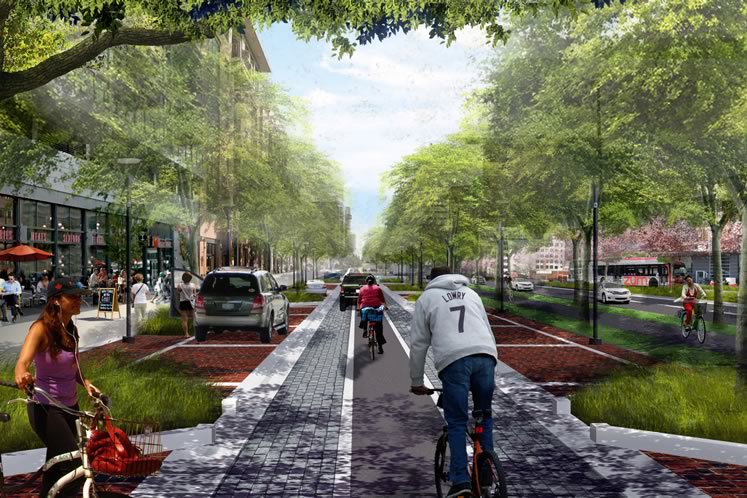
An artist’s rendering of an urban boulevard from a Brampton report on the new town centre it is proposing in the path of Highway 413. Courtesy of Brampton Planning & Development Committee.
Perhaps the most progressive element of Brampton’s plan is its “urban boulevard.” Based on similar models in Europe, it is a central corridor of use-specific lanes designated for cycling, transit, and local, flow-through and truck traffic, separated by landscaped boulevards.
The transportation ministry has dismissed the Brampton proposal as incompatible with the proposed highway. But Brampton is sticking to its guns. In a bid to garner wider support, it is taking the proposal on the road – and Caledon seems to be listening.
In October Brampton presented its plan to Peel regional council where an impassioned Patrick Brown asserted, “This is the way of the future. It’s a test of the type of communities we want.”
Caledon’s mayor and four regional councillors were in attendance. One of them was Ian Sinclair. Often considered a champion of the environment, particularly on aggregate extraction, Sinclair has been a reluctant supporter of the 413.
“I agree the last thing we need is to pave over more green lands,” he said in an interview earlier this fall, “but we have a major problem with truck traffic congestion on the existing highways. We need another highway.”
However, following the Peel council meeting, Sinclair said he was impressed by Brampton’s “ambitious and imaginative” urban planning initiative that is “contrary to a 400-series highway.” He added, “The 413 is a complex issue. The key function of the highway, in my view, is the movement of freight trucks through the GTA, which has become the majority distribution district for Canada. After that positive freight function, the merits of the 413 fall away rapidly.”
Johanna Downey agreed the Brampton plan “warrants a close look,” and the mayor and other regional councillors favoured inviting Brampton to present its plan to Caledon council as a whole.
In the meantime, Stop the 413 signs continue to proliferate on Caledon roadsides – and, in an echo of the broad-based support beyond these hills that shut down the Melancthon megaquarry eight years ago, the signs are also sprouting in downtown Toronto neighbourhoods.
In the offices of Environmental Defence, Tim Gray says, “We are now in the final stages of hiring a program manager with a background in planning and planning law to be able to support our legal and process work to fight the scheme.”
But he doesn’t think Ford’s highway will need to be defeated in court. He’s confident it will be defeated in the court of public opinion long before that.
Related Stories
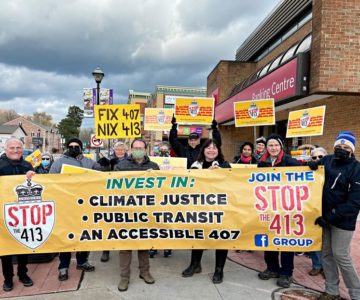
Why Highway 413 is a Bad Idea
Mar 29, 2022 | | EnvironmentThe “zombie” highway will hurt the environment, fail to solve the problems it aims to address – and there are better ideas to explore.

Conservation Authorities v. Doug Ford
Mar 31, 2021 | | EnvironmentThe provincial government is stripping Ontario’s conservation authorities of the very meaning of their name – and key protections for the environment.

No Green Recovery
Mar 31, 2021 | | Editor’s DeskThe Ford government has navigated Covid as well as or better than many – but at the same time, it has also escalated its pro-development agenda.
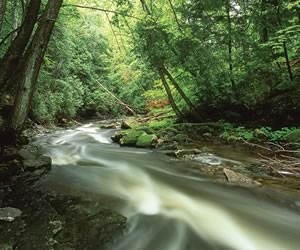
The Greenbelt: Letting the Belt out a Notch or Two
Mar 21, 2010 | | EnvironmentShould the Greenbelt be expanded? The central purpose of the plan is to protect farmland and environmentally sensitive land on the urban fringe.
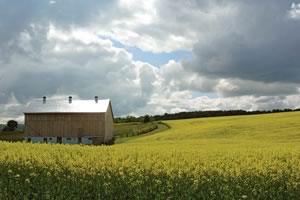
Agriculture in the Greenbelt
Mar 21, 2010 | | EnvironmentIn recent years farmers have been subjected to a plethora of regulations related to environmental protection and food safety. Has the pendulum swung too far?

Places to Grow turns 10
Jun 16, 2015 | | EnvironmentThe Growth Plan was an attempt to rein in the low-density sprawl that was a signature of development in the 1980s and 1990s.
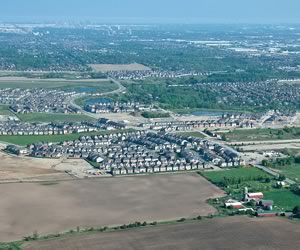
A different perspective on this place we call home
Jun 16, 2015 | | Back IssuesFor most of us “home” is a mythical place – constructed from a collective idea of who we are and how we live. It can be a very comfortable place and well worth celebrating.
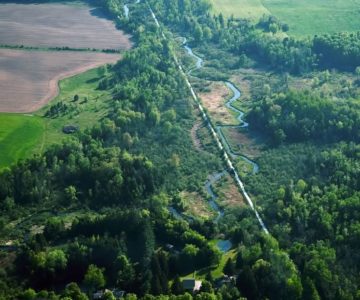
Finding Balance in Caledon: The Urban/Rural Divide
Jun 16, 2015 | | EnvironmentIn less than two decades Caledon’s population will be 75 per cent urban. Can its countryside values survive the shift?
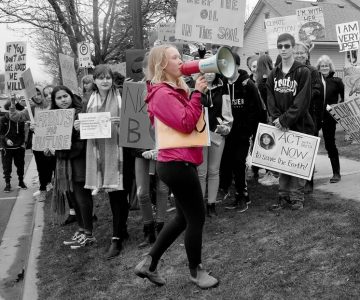
Climate Change and the Young
Jun 20, 2019 | | Environment“We the young have started to move.” Youth here and around the world raise a battle cry for action on climate change.

Wrens
Aug 30, 2011 | | EnvironmentBoth male and female wrens generate a potpourri of chatter – a profusion of messaging rivaling the texting of human teenagers.













Toronto has the 3rd worst traffic in north america (behind NYC and LA). Cities with more highways have less traffic (duh). For example look at Phoenix, Philadelphia, Detroit or Cleveland on Google traffic maps during rush hour and compare to Toronto. These are all cities with WAY more freeways relative to their population than Toronto.
Brad on Sep 3, 2023 at 8:19 pm |
If you ever drive from Milton to Toronto 7:30am to 11:00am, be prepared to average 60km and expect to be parked several times. Economy works by transportation being efficient, and it’s not on this corridor now.
413 is needed to support increasing population in GTA
Wishful thinking does not change the facts on 401.
Jack B
Jack Boychuk from halton hills on Jun 7, 2021 at 11:52 am |